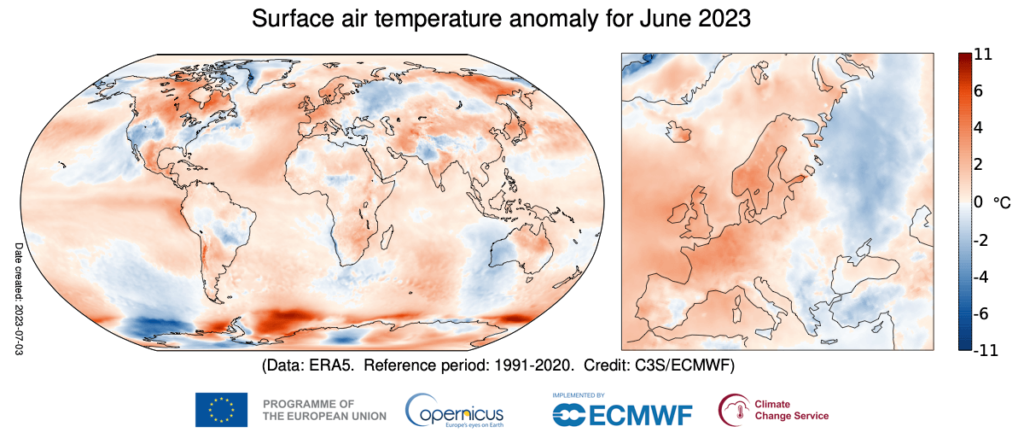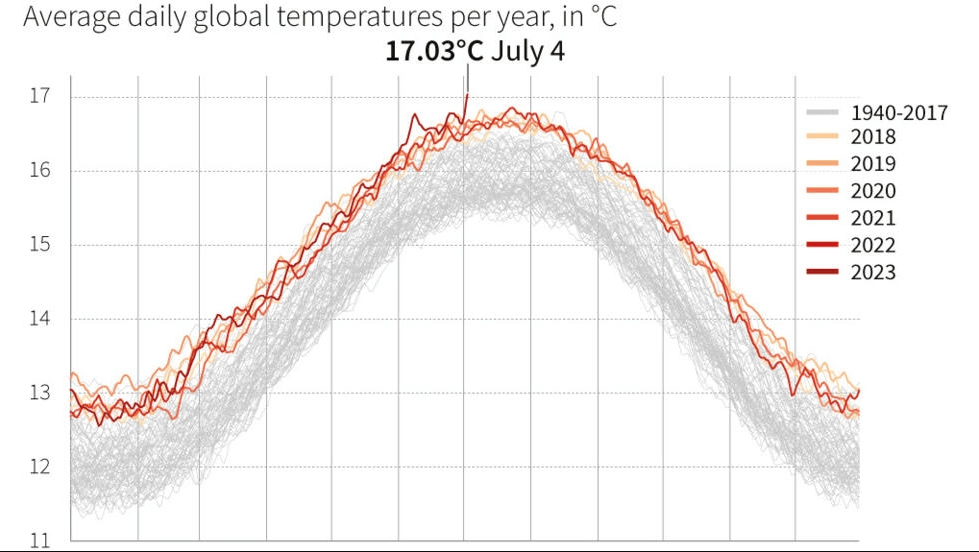
You are not alone if you think the past month was excessively hot. Science has determined that June 2023 was the hottest June on record, even as scientific modelling showed that this week saw the highest average daily global temperature ever.
A report published by the United Nations and the World Meteorological Organization and supported by data from the European Union's Copernicus Climate Change Service showed that traditionally the hottest month of the year was even hotter than ever recorded in history.
June 2023 saw an average temperature that was over 0.5°C above the average temperatures witnessed between 1991-2020, and smashing the previous record of June 2019, according to the Copernicus Climate Change Service, implemented by the European Centre for Medium-Range Weather Forecasting.

According to Copernicus, the warmer-than-usual June can also be evidenced by record June temperatures experienced across northwest Europe. Parts of Canada, the United States, Mexico, Asia, and eastern Australia were also significantly warmer than normal.
At the same time, it was cooler than normal over western Australia, the western United States, and western Russia.
July also warmer
The Copernicus ECMWF ERA5 dataset showed that the global average 2-meter temperature reached an all-time high of 16.88° C on July 3, breaking the previous daily record of 16.80°C from August 2016.
According to the preliminary data, It broke this record again on July 4, with a temperature of 17.03 °C.
https://twitter.com/CopernicusECMWF/status/1676624398458191872?s=20
The University of Maine, which set up the Climate Reanalyzer tool, calculates an estimated average global temperature for each day since 1979. On Monday, July 3, this curve reported a high of 17.01 degrees Celsius (62.62 degrees Fahrenheit). That record was surpassed on Tuesday with 17.18C (62.92F) and again on Thursday with 17.23C (63.01F).

"The exceptional warmth in June and at the start of July occurred at the onset of the development of El Niño, which is expected to further fuel the heat both on land and in the oceans and lead to more extreme temperatures and marine heatwaves," said Prof. Chris Hewitt, WMO Director of Climate Services.
"We are in uncharted territory, and we can expect more records to fall as El Niño develops further, and these impacts will extend into 2024," he said. "This is worrying news for the planet," he said.
"Global sea surface temperatures were at record highs for the time of the year both in May and June. This comes with a cost. It will impact fisheries distribution and the ocean circulation in general, with knock-on effects on the climate. It is not only the surface temperature, but the whole ocean is becoming warmer and absorbing energy that will remain there for hundreds of years. Alarm bells are ringing especially loudly because of the unprecedented sea surface temperatures in the North Atlantic, "said Prof. Hewitt.
"Our dangerous race towards 1.5C continues with what may have been the warmest week on record," said David Carlin, Head of the Climate Risk at the United Nations Environment Programme (UNEP).
He reminded us that the record average daily temperatures reported were not just records for certain places "but for the Earth as a whole."
Even though the data was preliminary, he said that it was hard to dispute the statement from United Nations Secretary-General António Guterres that "climate change is out of control."
'We need to up our efforts on mitigation and adaptation, and ensure COP 28 delivers for people and planet!"
The rising temperatures contributed to extreme marine heatwaves observed around Ireland, the United Kingdom and the Baltic Sea.
The UN said a wetter-than-average June was witnessed over most of southern Europe, western Iceland and north-western Russia, with heavy precipitation leading to floods.
Extratropical wetter-than-average regions included western North America, regions of south-western Asia, Japan, South Africa, Brazil, Chile, New Zealand, and a large region of Australia; Japan and Pakistan were hit by typhoon Mawar and cyclone Biparjoy, respectively.
A report published by the United Nations and the World Meteorological Organization and supported by data from the European Union's Copernicus Climate Change Service showed that traditionally the hottest month of the year was even hotter than ever recorded in history.
June 2023 saw an average temperature that was over 0.5°C above the average temperatures witnessed between 1991-2020, and smashing the previous record of June 2019, according to the Copernicus Climate Change Service, implemented by the European Centre for Medium-Range Weather Forecasting.

According to Copernicus, the warmer-than-usual June can also be evidenced by record June temperatures experienced across northwest Europe. Parts of Canada, the United States, Mexico, Asia, and eastern Australia were also significantly warmer than normal.
At the same time, it was cooler than normal over western Australia, the western United States, and western Russia.
July also warmer
The Copernicus ECMWF ERA5 dataset showed that the global average 2-meter temperature reached an all-time high of 16.88° C on July 3, breaking the previous daily record of 16.80°C from August 2016.
According to the preliminary data, It broke this record again on July 4, with a temperature of 17.03 °C.
https://twitter.com/CopernicusECMWF/status/1676624398458191872?s=20
The University of Maine, which set up the Climate Reanalyzer tool, calculates an estimated average global temperature for each day since 1979. On Monday, July 3, this curve reported a high of 17.01 degrees Celsius (62.62 degrees Fahrenheit). That record was surpassed on Tuesday with 17.18C (62.92F) and again on Thursday with 17.23C (63.01F).

"The exceptional warmth in June and at the start of July occurred at the onset of the development of El Niño, which is expected to further fuel the heat both on land and in the oceans and lead to more extreme temperatures and marine heatwaves," said Prof. Chris Hewitt, WMO Director of Climate Services.
"We are in uncharted territory, and we can expect more records to fall as El Niño develops further, and these impacts will extend into 2024," he said. "This is worrying news for the planet," he said.
"Global sea surface temperatures were at record highs for the time of the year both in May and June. This comes with a cost. It will impact fisheries distribution and the ocean circulation in general, with knock-on effects on the climate. It is not only the surface temperature, but the whole ocean is becoming warmer and absorbing energy that will remain there for hundreds of years. Alarm bells are ringing especially loudly because of the unprecedented sea surface temperatures in the North Atlantic, "said Prof. Hewitt.
Climate change is out of control
"Our dangerous race towards 1.5C continues with what may have been the warmest week on record," said David Carlin, Head of the Climate Risk at the United Nations Environment Programme (UNEP).
He reminded us that the record average daily temperatures reported were not just records for certain places "but for the Earth as a whole."
Even though the data was preliminary, he said that it was hard to dispute the statement from United Nations Secretary-General António Guterres that "climate change is out of control."
'We need to up our efforts on mitigation and adaptation, and ensure COP 28 delivers for people and planet!"
The rising temperatures contributed to extreme marine heatwaves observed around Ireland, the United Kingdom and the Baltic Sea.
The UN said a wetter-than-average June was witnessed over most of southern Europe, western Iceland and north-western Russia, with heavy precipitation leading to floods.
Extratropical wetter-than-average regions included western North America, regions of south-western Asia, Japan, South Africa, Brazil, Chile, New Zealand, and a large region of Australia; Japan and Pakistan were hit by typhoon Mawar and cyclone Biparjoy, respectively.

